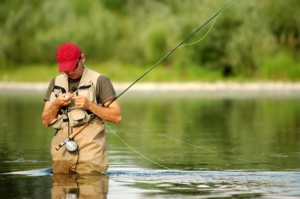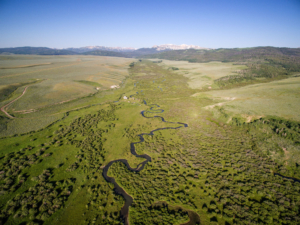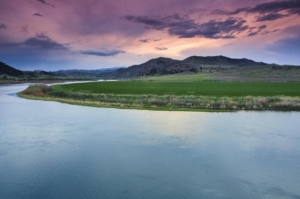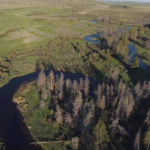Rivers Run Through the Mountain West

Each spring a remarkable transformation overtakes the Mountain West. As the long winter gives way to the first signs of spring, the snowfields begin to recede, breathing fresh life into the surrounding rivers, lakes and creeks. To the outdoor enthusiast and the causal recreationalist alike, this perennial thaw is something of an invitation back into the wilds after an icy hiatus. And to none does it call more clearly than to those with a rod, a reel and fly box.
Vast watersheds and an abundance of native swimmers make Montana, Wyoming, Idaho and Colorado the envy of the world’s fly-fishing community. Each year, anglers from around the globe flocks to these local waters, which now support a multi-million-dollar industry.
The growing popularity has increased traffic on many of the region’s rivers, reemphasizing the need for prudent environmental management. But one of the blessings to such rolling expanse is that plenty of waters remain largely undiscovered. As many locals in any number of small towns will tell you, follow a dirt road around here long enough and you are sure to find an untouched river, creek or lake glinting with native salmonids.

Wyoming
Yellowstone and Grand Teton National Parks have become synonymous with Wyoming fishing, and, as a result, the area’s rivers are rife with drift boats year-round, and particularly during peak summer months. But the Cowboy State’s rivers hardly begin or end at the Park boundaries. From the Little Bighorn to the Green River and the North Platte to the Greys River, Wyoming’s 27,000 miles of fishable rivers provide a broad range of conditions and variability for anglers looking to get off the beaten path.
Just ask Laura Hattan, owner of the Great Outdoor Shop in Pinedale, Wyoming. In 2005, Hattan and her family left a comfortable life in Nebraska to pursue the outdoors of the Wind River Range.
“The benefits of being here are hedonistic,” she tells Outside Magazine. “I love playing in the mountains. But there’s also a greater benefit in watching my daughter grow up in the mountains, in an environment that’s almost endangered in this country.”
More than 22 species of gamefish swim in Wyoming’s waters, but the state is most famous for its trout, including cutthroat, brook, brown, lake, and rainbows. Cutthroats are the only trout native to Wyoming.
A word of caution to anglers: on waters that flow through private land, individuals must remain in their vessel. Shore fishing or wading is only allowed with permission from the landowner. And always go prepared. Like much of the Mountain West, many of Wyoming rivers and streams traverse bear habitat. Always carry bear spray and give wildlife their space.

Montana
The vast grandeur of Montana belies the accessibility of its lakes and rivers. Here, the fishing lives up to its reputation in literature and film.
“Outdoor recreation as a whole is the cornerstone of tourism in Montana,” explains Jennifer Pelej, an administrator for the Montana Office of Tourism and Development. “We have an audience that wants to come here for free-spirited adventure. Fly fishing really embodies that.”
Near the northern border, Craig, Montana serves as a gateway to some of the state’s best fishing. Home to only about 40 people, the town boasts three fly shops. And a big run-off year like this promises they will stay busy.
Half an hour outside of Bozeman, anglers can put their paddle boats on the Missouri River, the longest river in North America. Formed by the confluence of the Madison and Jefferson Rivers, and joined by the Gallatin a mile downstream, the Missouri provides trophy trout fishing. A 35-mile stretch below Holter Dam is famous for its dry-fly fishing a mecca for fishermen and women.
Near Twin Bridges, Montana, the Big Hole River has been called the “prettiest river in Montana.” It’s no wonder it has become a destination for those seeking a full experience on the river. Ideal for wading and floating alike, the Big Hole is home to the last native fluvial Arctic grayling in the Lower 48.
Idaho
Generally mild winters provide for early fishing across Idaho, and a surprising variety. During the spring, murky waters and colder conditions can present a challenge, but nothing a fly box full of streamers and wet flies can’t overcome.
Henry’s Fork, a famed stretch of river, gets an early start on rainbow trout. Fishing conditions continue to improve throughout the spring and into the summer, with hatches evolving throughout. A sunny day can make for an unforgettable experience.
On the South Fork, the Lodge at Palisades – an Orvis-endorsed destination – provides the conveniences and accessibility of a world-class facility. For those looking for a less commercial experience, the nearby Swan Valley offer many put-in points to this stretch of river that houses 7,000 trout per mile along braids, riffles, banks and cut-offs.
Live the Life
For both avid outdoorspeople and those seeking a quiet retreat into the wilderness, the Mountain West offers unrivaled fishing. Contact our team to learn more about properties that put this lifestyle at your fingertips. From renown fishing lodges to heritage ranches that provide access to world-class waters, no one knows the region better.
*Article courtesy of Western Ranches, a division of Jackson Hole Real Estate Associates.


